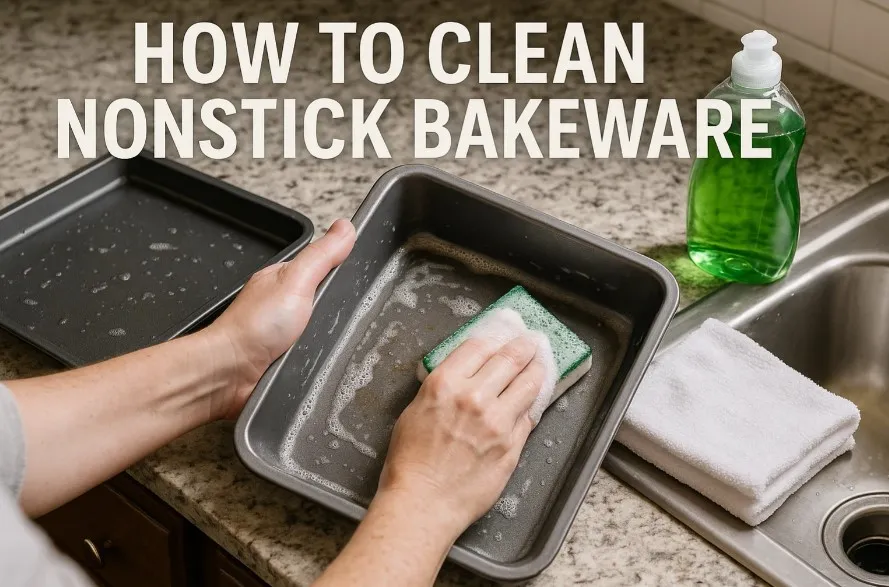To clean nonstick bakeware gently, soak it in warm, soapy water first, then use a soft sponge or nylon brush—never metal scrubbers! For stubborn stains, mix baking soda and water into a paste, scrub lightly, then rinse.
Are you tired of scrubbing stubborn residue off your non-stick bakeware, only to find that your favorite pans are losing their slick surface? Properly cleaning non-stick bakeware is essential not just for maintaining its aesthetic appeal but also for ensuring its longevity and safe cooking performance.
Knowing how to clean non-stick bakeware effectively can dramatically extend its lifespan and keep your baked goods effortlessly releasing from the pan.
In this comprehensive guide, we’ll explore everything you need to know about cleaning non-stick bakeware — from gentle methods that preserve the coating to effective techniques for removing baked-on messes.
Whether you’re a seasoned baker or an occasional cook, mastering these cleaning strategies will help you enjoy perfectly maintained bakeware for years to come.
“A well-maintained nonstick pan is a baker’s best friend.” – Julia Child
Understanding the Composition of Non-Stick Bakeware and Its Care Requirements
Before diving into cleaning techniques, it’s vital to understand what makes non-stick bakeware unique and how this influences your cleaning approach. Non-stick coatings are typically made of PTFE (polytetrafluoroethylene) or ceramic materials designed to prevent food from sticking, making baking and cleanup easier.
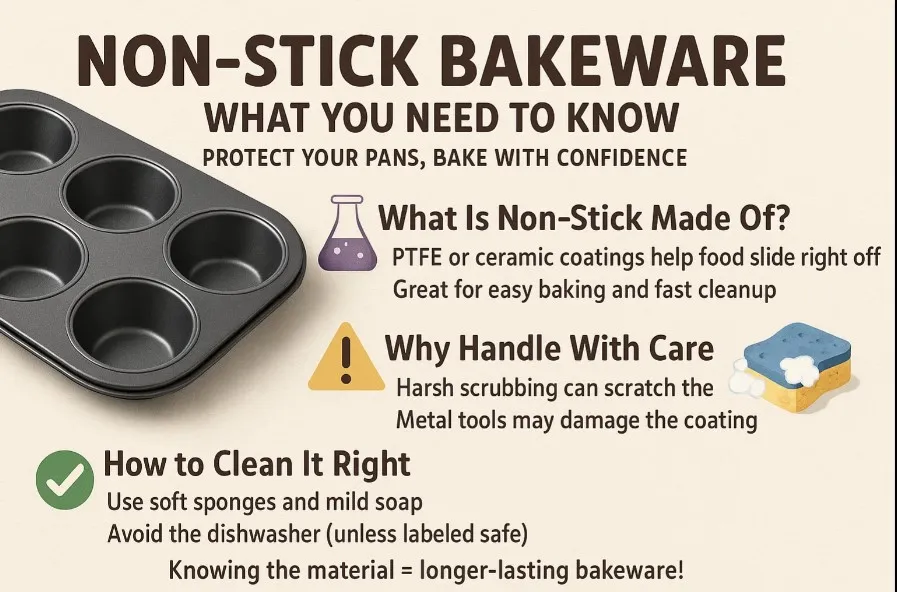
This section explores the core principles behind non-stick coatings, why they need gentle handling, and the common pitfalls that can damage their surface. By understanding these fundamentals, you’ll be better equipped to choose safe and effective cleaning methods, optimizing both the performance and lifespan of your bakeware.
What Are Non-Stick Coatings Made Of?
Non-stick coatings primarily consist of PTFE, known for its low friction properties, durability, and heat resistance. These coatings form a smooth, slick surface that prevents food from bonding tightly, making them ideal for baked goods and roasted vegetables alike.
More recently, ceramic-based non-stick coatings have gained popularity due to their eco-friendly profile and high-temperature tolerance. While these coatings share similar benefits, their care requirements may differ slightly, demanding specific cleaning approaches.
Why Proper Maintenance Is Crucial
While non-stick coatings are designed to withstand regular baking tasks, improper cleaning can compromise their integrity. Scraping with metal utensils, abrasive cleaners, or using harsh scouring pads can scratch or peel the coating, exposing the underlying metal which may rust or affect food safety.
Understanding that non-stick surfaces are delicate helps you avoid accidental damage. Regular, gentle cleaning preserves the coating, maintains non-stick properties, and ultimately saves money by prolonging the life of your bakeware.
Common Damage Factors and How to Prevent Them
Accidents happen, but many can be avoided through mindful maintenance. High heat, sharp utensils, and abrasive cleaning tools are primary culprits in damaging non-stick surfaces.
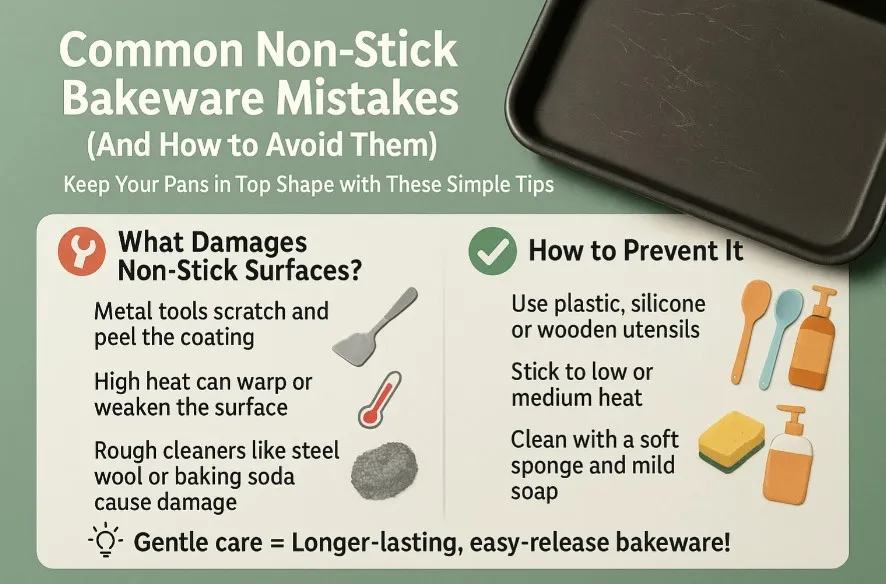
Using metal spatulas or knives on non-stick pans can gouge the surface, leading to peeling. Similarly, applying baking soda or steel wool abrasives during cleaning can scratch or strip the coating. To prevent such damage, always opt for soft sponges or cloths, utilize plastic or wooden utensils, and avoid overheating your bakeware.
By understanding the nature of non-stick coatings and how they function, you’re better positioned to implement appropriate cleaning routines. Treat your bakeware with care, and it will reward you with effortless release and pristine appearance for many baking sessions ahead.
“Patience and gentle care keep nonstick pans performing like new.” – Martha Stewart
Gentle Cleaning Techniques to Preserve Your Non-Stick Surface
Cleaning non-stick bakeware requires a delicate touch. The goal is to remove baked-on residues without compromising the non-stick coating. Using the right tools and methods ensures your bakeware stays in optimal condition, maintaining its non-stick properties over time.
In this section, you’ll learn about the most effective gentle cleaning techniques suitable for everyday maintenance and light stains. These practices can be incorporated into your regular cleaning routine, helping you avoid unnecessary wear and tear.
Using Warm Soapy Water and Soft Sponges
Start with the simplest method: washing your bakeware with warm water and mild dish soap. This process is effective for routine cleaning and helps prevent buildup of oils and residues.
Steps:
- Fill your sink or a basin with warm water.
- Add a few drops of gentle dish soap.
- Submerge the bakeware and let it soak for 10-15 minutes to loosen stuck-on particles.
- Use a soft sponge or microfiber cloth to gently wipe away grime.
- Rinse thoroughly with warm water and dry with a soft towel.
This method minimizes scratches and preserves the integrity of the non-stick layer. Regular gentle cleaning reduces the need for harsher methods later.
The Role of Baking Soda and Mild Abrasives
For minor stubborn stains, baking soda offers a gentle abrasive alternative that can help lift baked-on grease without damaging the surface.
Application tips:
- Mix baking soda with a small amount of water to form a paste.
- Apply the paste to the stained areas.
- Let sit for 15-20 minutes, allowing it to break down residues.
- Gently scrub with a soft sponge or cloth.
- Rinse thoroughly and dry.
Avoid using steel wool or abrasive scrubbers as they can scratch the coating, diminishing its non-stick capabilities.
Vinegar Solutions for Stubborn Residues
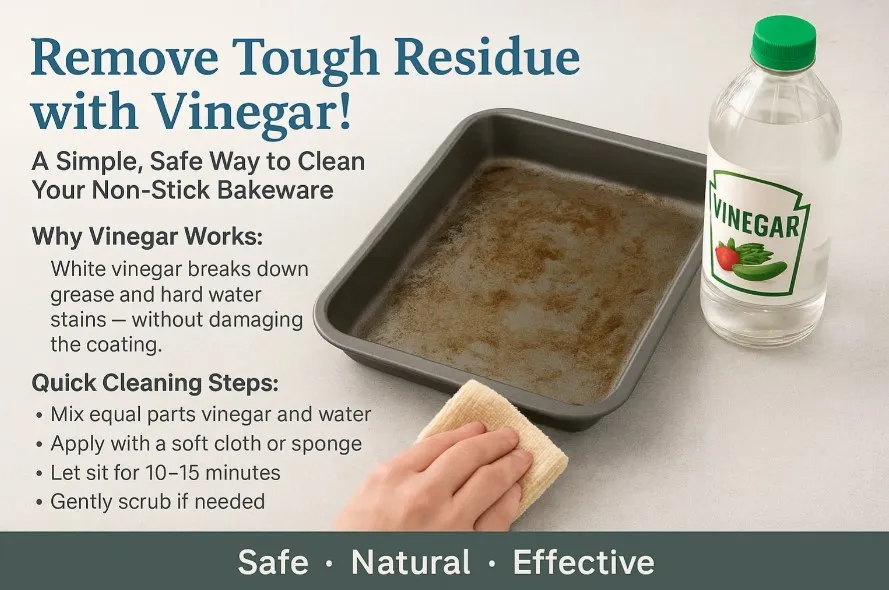
White vinegar is excellent for degreasing and removing mineral deposits or hard water stains. Its acidity helps dissolve stubborn residues without harming the non-stick surface.
Procedure:
- Mix equal parts white vinegar and water.
- Wipe the solution onto the bakeware with a soft cloth or sponge.
- Let it sit for 10-15 minutes.
- Gently scrub if necessary, then rinse with warm water.
- Dry thoroughly.
Vinegar cleaning is particularly useful for older bakeware or those with persistent stains that don’t respond to soap and water.
Final Tips for Gentle Cleaning
- Always use non-abrasive tools—avoid metal utensils, steel wool, and harsh scrubbing pads.
- Never put non-stick bakeware in the dishwasher unless specified by the manufacturer, as high heat and detergents can degrade the coating.
- Regular cleaning after each use prevents buildup, reducing the need for heavy-duty scrubbing.
Employing gentle, consistent cleaning practices protects the non-stick surface while keeping your bakeware looking new. Warm soapy water, baking soda, and vinegar are your best friends in preserving the non-stick coating, ensuring easy-release baking for years to come.
Removing Baked-On Stains and Grease Without Damaging Your Bakeware
Despite your best efforts, sometimes baked-on oil, food residue, or discoloration can become stubbornly ingrained into your non-stick bakeware. These residues threaten to diminish the non-stick qualities and make cleaning more difficult. However, with the right techniques, you can restore your bakeware’s surface without risking damage.
This section dives into advanced cleaning methods for tackling tough stains, emphasizing safe approaches that respect the integrity of your non-stick coating.
Mechanical Methods for Heavy Buildup
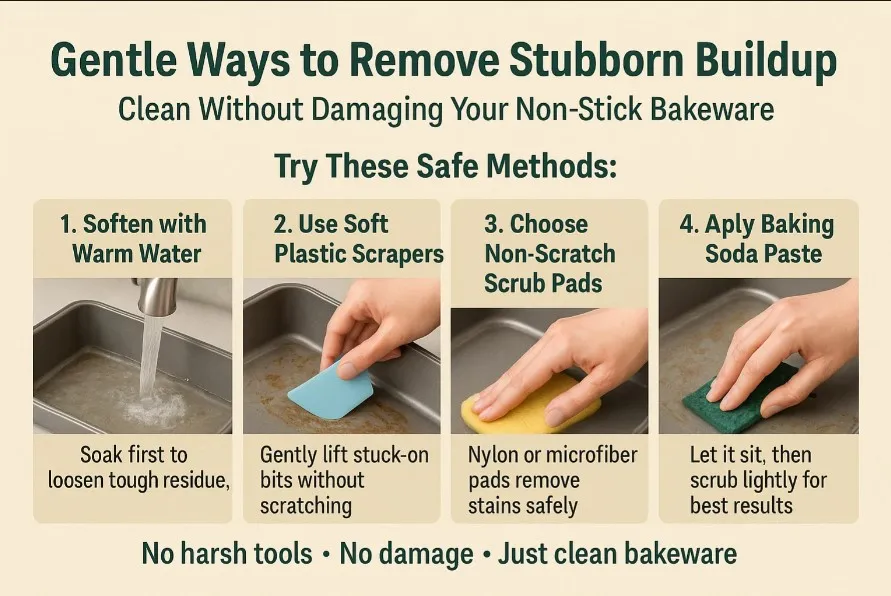
When faced with heavily baked-on residues, gentle mechanical intervention is often necessary. But this doesn’t mean resorting to abrasive tools; instead, employ methods that combine patience with finesse.
Soft Plastic Scrapers
Use a plastic scraper or spatula to gently lift baked debris. Placing the bakeware in warm water beforehand softens the residues, making removal easier.
Non-Abrasive Scrubbing Pads
Invest in non-scratch scrub pads like those made from nylon or soft microfibers. These can dislodge stubborn residues without scratching the coating.
Baking Soda Paste and Gentle Agitation
As previously discussed, baking soda paste combined with patience and gentle scrubbing can effectively break down encrusted stains.
Natural Remedies for Tough Stains
Natural solutions can be surprisingly effective for cleaning baked-on residues without chemicals or abrasives.
Baking Soda and Vinegar Reaction
Apply baking soda paste, followed by spraying or pouring a small amount of vinegar over it. The fizzing reaction helps lift residues.
Salt and Lemon Juice
Create a paste with coarse salt and fresh lemon juice. Use this mixture to scrub stubborn spots. The citric acid and abrasive salt work synergistically to loosen residues.
Hydrogen Peroxide with Baking Soda
For persistent discoloration or stains, a mixture of hydrogen peroxide and baking soda can brighten and clean the surface. Apply carefully and rinse thoroughly afterward.
Avoiding Damage During Deep Cleaning
When dealing with heavy stains, restraint is key. Do not impulsively scrub with steel wool, steel brushes, or other harsh tools that can strip the non-stick coating. Instead, patience, gentle pressure, and natural cleaning agents will do the trick without risking damage.
When to Seek Professional Help or Replacement
Sometimes, despite all efforts, stains or residual damage may be unavoidable. If your non-stick bakeware is heavily scratched, peeling, or warped, replacement might be the safest option. Continuing to use compromised bakeware can lead to ingestion of degraded coating particles or uneven heating.
Heavy-duty cleaning requires a delicate balance between effective stain removal and preservation of your non-stick surface. Employing soft tools, natural remedies, and strategic patience allows you to restore your bakeware’s appearance and functionality safely.
FAQs About How to Clean NonStick Bakeware Effectively
How often should I clean my non-stick bakeware?
Regular cleaning after each use is recommended to prevent buildup and staining. A quick wash with warm soapy water usually suffices for routine maintenance. For baked-on residues, occasional deep cleaning may be necessary.
Can I use metal utensils or abrasive scrubbers on non-stick bakeware?
No. Metal utensils and abrasive scrubbers can scratch and damage the non-stick coating, leading to peeling and reduced effectiveness. Always opt for soft silicone, plastic, or wooden utensils, and use non-abrasive cleaning tools.
Is it safe to put non-stick bakeware in the dishwasher?
Check the manufacturer’s instructions. Many non-stick items are dishwasher safe, but repeated exposure to high heat and harsh detergents can diminish the coating’s lifespan. Hand washing is generally preferred for longevity.
What are the best natural cleaning agents for stubborn stains?
Baking soda, vinegar, lemon juice, and salt are excellent natural options. They are effective, gentle, and environmentally friendly, helping you maintain your bakeware without risking damage.
How can I prevent damage to my non-stick bakeware?
Avoid using metal utensils, abrasive cleaning tools, and high heat beyond the manufacturer’s recommendations. Clean promptly after use, and store bakeware properly to prevent scratches and warping.
Conclusion
Maintaining your non-stick bakeware in pristine condition hinges on employing gentle, effective cleaning techniques that respect the delicate coating. Regular washing with warm soapy water, coupled with natural remedies like baking soda and vinegar, can handle most everyday messes.
For stubborn stains, careful mechanical removal and natural abrasive mixes can restore your bakeware’s appearance without damage. Remember, prevention is key—using appropriate utensils, avoiding harsh abrasives, and mindful storage will extend the life of your non-stick cookware.
By mastering these methods, you’ll ensure your bakeware remains a reliable and efficient tool in your kitchen for countless delicious creations ahead.
“A clean pan is the secret to perfect baking every time.” – Ina Garten

